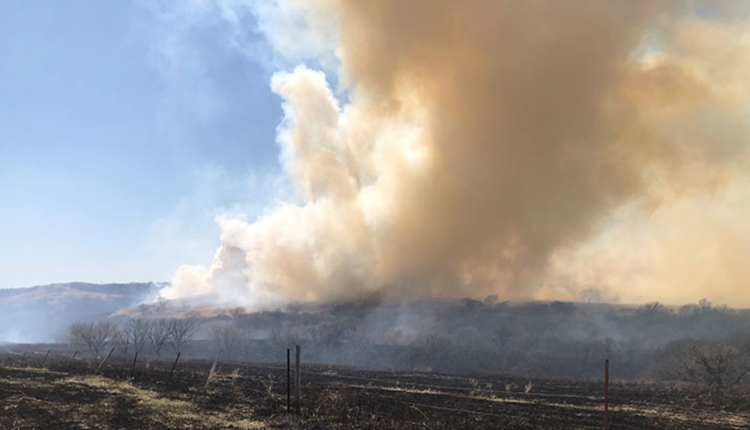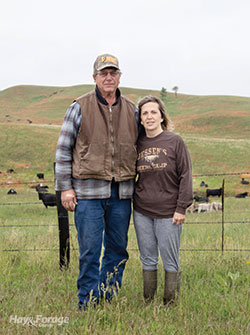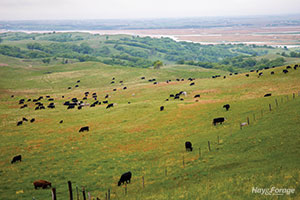The author served as the 2021 and 2022 Hay and Forage Grower summer editorial intern. She currently attends Iowa State University where she is majoring in agricultural communications and agronomy.

Most farm fires are created by accident. Electrical sparks fly, engines run too hot, and wet hay spontaneously combusts. However, there is one instance when fires are planned for and set intentionally.

Jessen Ranch was established by Tim’s grandfather in the 1940s in the northeastern part of the Cornhusker State, overlooking the Lewis and Clark Lake, which is a part of the Missouri River. Its address doesn’t register on a smartphone map, and the closest city is over 40 miles away. Needless to say, gas stations and grocery stores en route to the ranch are few and far between.
The Jessens’ homestead is surrounded by rolling hills dotted with patches of forest and gaping gullies resulting from previous soil erosion. When Tim’s father, Gene, began farming here in 1952, the tricky terrain wasn’t the only thing causing him trouble. Invasive red cedar trees were outcompeting the desirable forages.
To give the native grasses on the land a fighting chance, Gene began administering prescribed fires every spring. The fires eventually eliminated most of the red cedar trees and allowed sunlight to reach the soil and stimulate the growth of different forage species. In the 1980s, Gene also transitioned from continuously grazing cattle to a rotational grazing approach, which encouraged even more plant diversity.
“Before the 1980s, Dad did like everybody else: Cows were in the pasture the first of June and rounded up in the fall,” Tim said. “When he got into rotating, the diversity in the pasture increased — mostly in a positive way.”
Gene passed away in 2018, but his legacy of land stewardship lives on through Tim and Annie, who have since moved to the farm and started managing the 2,400-acre operation. Tim continues to demonstrate his father’s affinity for sustainable agriculture in combination with his own interest in raising beef cattle by custom grazing roughly 350 cow-calf pairs on Jessen Ranch each year.
Restoring and renting land
Prescribed burns are still carried out on Jessen Ranch; however, they aren’t required annually like they used to be. Tim surveys his pastures for red cedar trees and decides to burn if there are enough popping up. He also considers the weather conditions to determine when it is safe to set a fire. In some years, Tim burns as early as February, whereas in others he will wait until May. Most of the time, burning takes place in late March or April.
The Jessens control the prescribed fires themselves and with assistance from neighbors. To prevent flames from crossing property lines, they backburn along shared fences. This technique is often used to curtail a wildfire’s path of destruction and involves setting smaller fires ahead of a larger one to expend any resources that could be used as fuel. But even with this protocol in place, the burn site must be monitored with a close eye.
“It’s stressful,” Tim stated. “The work really starts when the burning is done because for three or four days — or whenever you get moisture — you have to babysit the fire until it’s out. You have to worry about it spreading in the middle of the night.”
When the fire is fully extinguished, Tim custom grazes for a livestock producer who lives roughly an hour away. Cows and calves usually arrive sometime in April, along with a few bulls. The different classes of livestock ride separate trucks for ease of transportation and animal safety. Once they have been unloaded in the cattle yard near the Jessens’ house, it only takes two or three hours for most cow-calf pairs to reunite.
Calves graze alongside their mothers for several weeks until they return to the cattle yard for weaning. After a couple of days of bellowing and long-winded moos, the calves are shipped back to their home farm. Then breeding season begins, which aligns well with plant growth.
Learning by doing
Most of the property is composed of warm-season grasses, offering an abundance of forage when cows’ energy requirements start to rise. Pastures are primarily based on little bluestem, big bluestem, and switchgrass, although Tim said an analysis from the Natural Resource Conservation Service showed more than 100 species of forbs and other grasses are present. This includes some cool-season grasses such as wild oats, Kentucky bluegrass, and different types of fescue that help extend the grazing window.

Permanent water tanks have also been installed. One main holding tank is filled with water from a nearby dam via underground water lines. Then the water is allocated to water tanks in the pasture, and one tank services two to three paddocks. This system is fully functional now, but there was some trial and error along the way.
“My mistake early on was making the water lots too small,” Tim admitted. “You would think if you made the tanks big enough to hold three-fourths of a herd, it would be fine. But we’ve had to make them about four times the size of that.”
Cattle move through the paddocks quickly the first time around, completing a full rotation in a little over a month. Then as the summer progresses, paddocks receive longer periods of rest to ensure adequate recovery and regrowth. As a rule of thumb, cattle graze half of the available forage and the other half is left standing.
“When you get the winds that we have, leaving that thatch of grass on the ground keeps the soil from drying out,” Tim said. “A lot of these ridges are just gravel and sand. If you take all the grass off and get a week of 100°F weather, it will just bake the roots.”
Over the years, Tim has observed grazing behavior that has helped him time his rotations. The herd tends to graze in a circular pattern as a single unit, with only a few outliers straying away from the group. He also noted not all paddocks are uniform in size, so some grazing circles in the grass are completed faster than others. Nonetheless, once the animals have made a loop, he moves them to the next section to prevent overgrazing.
Shorter occupation time not only prevents overgrazing, but it prevents pinkeye, too. Tim has found significantly fewer outbreaks of pinkeye when rotations only last three to five days. Flies that carry pinkeye-causing bacteria lay eggs in cow manure, so moving cattle before these insects have time to hatch minimizes the spread of infection.
In addition to grazing, a small portion of land is seeded to alfalfa. Even though the cows exclusively graze grass and are returned to their owner at the end of the grazing season, Tim makes sure to have some hay on hand in case something goes awry. For example, one year an unexpected snowstorm in the fall prevented trucks from navigating to the farm. Tim kept the cows and fed them hay until the roads were clear and they could finally go home.
Calling for border collies
Moving cattle on Jessen Ranch is an undertaking. The steep slopes are difficult to summit in four-wheel drive, and the gullies are so deep that cows seem to get lost inside. Therefore, rather than wrangling cattle on all-terrain vehicles (ATVs), the Jessens rotate their herd with the help of border collies.
When Tim’s brother started raising border collies eight years ago, he paid him a visit one day and was inspired by what the dogs could do. Tim realized their talents would be instrumental to rotational grazing, and soon after, he and Annie acquired and began raising border collies of their own.
On the ranch, the young dogs begin by driving a group of steers in a lot close to the Jessens’ house. But their skills are truly put to the test in the pasture.
The canines know it is time to corral cows when they see Tim approach their kennels. They patiently wait for his command to jump up into the bed of his truck and are instantly on the lookout for their grazing subjects. Once the red and black cows have been spotted against the green grass, the dogs eagerly enter the field and carefully listen to Tim’s directions. They know when to approach the animals, when to back away, and how to parade them through the gate and into the next paddock.
“It used to be being pretty hard to get the cattle to move, but now I just sit in my side-by-side drinking my coffee while the dogs move them for me,” Tim laughed.
As the dogs’ herding abilities heat up, the Jessens’ pastures continue to improve. With prescribed burning and rotational grazing, there is seldom a red cedar tree in sight. What is in full view, though, are the positive effects their practices have had on the land. Although Tim and Annie can successfully control a large fire, the passion they have for their farming lifestyle is one flame they just can’t put out.
This article appeared in the February 2023 issue of Hay & Forage Grower on pages 6-8.
Not a subscriber? Click to get the print magazine.

